

| Mapping the distribution of the Rosemary Beetle across Nottinghamshire |
| With a bad reputation amongst most Nottinghamshire gardeners, the beautifully coloured Rosemary Beetle is an unwanted visitor to many of the county's meticulously cultivated gardens. And in some case quite rightly so, because if numbers build up, the damage to plants can be tremendous. | ||
| ... | ||
| But based on personal observations, numbers of
the Rosemary Beetle Chrysolina
americana (Linnaeus, 1758) still
seem small at any one site and it seems not to occur anywhere near those
which can be experienced by the UK's commercial Lavendar growers. Although known to feed on a number of plants, primarily, this beetle gets its name from its preference for the leaves of Rosemary Salvia rosmarinus, a perennial, woody herb grown commonly in UK parks and gardens. Chrysolina americana is one of many insects to have appeared in the UK relatively recently, no doubt benifitting from the worldwide horticultural importation trade. It first appeared in the UK in the 1990's and has steadily spread north since and is now widespread with records north into Scotland. With Rosemary and Lavender becoming increasingly popular in gardens and as part of landscaping plantings around offices and housing estates, Chrysolina americana records away from urban areas and larger rural villages are few. Despite the inclination within its scientific name, it does not (as may be expected) originate from America. It was in fact, originally a southern European species. |
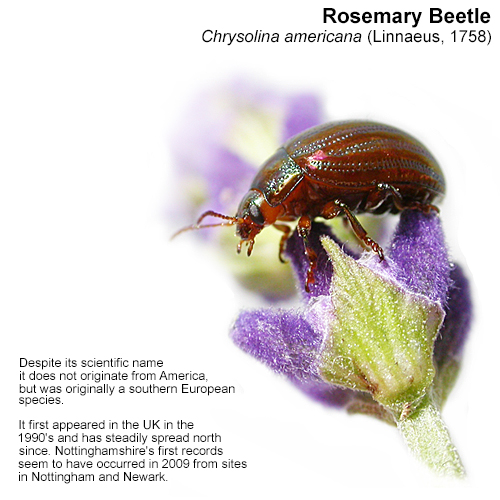 |
|
| .......... | ||
|
Nottinghamshire
records This is a stunning and beautiful beetle, which despite appearing almost dark brown from a distance, shows an almost rainbow-like colouration on the head, pronotum and elytra when viewed closely. The adults are around 8-9mm, so it is not a small species and is usually conspicuous if present. Adults can be found near the end of any stems, even during mild Winter weather. |
||
| .... | ||
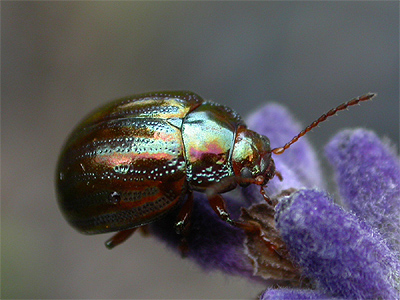 |
Chrysolina americana first appeared in the UK in
the 1990's, when found outdoors at RHS Garden Wisley in 1994. However,
this population was not self-sustaining and it was not found again until
appearing in London and Reading in 1999. In 2003 it was refound at RHS
Garden Wisley and by 2005, had become established and had increased its
UK range substantially *. * (Source:- https://www.rhs.org.uk/science/help-our-research/rosemary-beetle) Nottinghamshire's first record is listed on the NBN Atlas and was sent in as part of the Royal Horticultural Society's Rosemary Beetle Monitoring Scheme. The scheme is still ongoing, but Nottinghamshire's first record is poorly documented and to be honest, rather vague. The record is dated as 19/06/2006, but a two figure grid reference of SK76 is hardly worth giving in terms of a valuable record It means that the actual record could have come from a wide area. Furthermore, its not helped that the location of SK76 is then given as being Northampton, of which which SK76 certainly isn't. |
|
| .... |
| A quick check revealed that SK76 is actually in the Winkburn and Maplebeck area, but could stretch west towards Eakring, or north to Kersall. Unfortunately, such a vague record can't really be considered as a county first, even though Chrysolina americana certainly was in Nottinghamshire in 2006. |
| .... |
| Nottinghamshire's first
well documented records seem to have occurred within a few days in late
June 2009, from sites at Newark on 26/06/09, Mapperley, Nottingham on
28/06/09 and Stapleford on 29/06/09. Our first record came from the courtyard of the old Edwinstowe Craft Centre, now home to the Sherwood Forest Trust on 01/06/11. This was a beetle we had looked for over the course of the previous couple of years and I distinctly remember at the time, suggesting to Dilys that she ought to have a check for Rosemary Beetle on the Rosemary growing there. Within a couple of minutes she'd found one! We recorded it from Edwinstowe Craft Centre again in 2012 and as far as is known at the time of writing (June 2020) it is still present there, although much of the Rosemary has been removed. Over the following few years it was recorded from other sites at Edwinstowe, from a number of sites scattered across the Mansfield and Ashfield areas, but the vast majority of records have come from suburban Nottingham, especially north-west of the City centre. What is interesting on the distribution map produced by our own records and of those directly sent in to us, is the broad corridor producing no Chrysolina americana records at all. This corridor roughly stretches from West Bridgford in the south-east, north-west across central Nottingham (St Anns, The Meadows, Radford and Whitemoor etc) across to Aspley. While it could be expected that interest in wildlife within inner city Nottingham would be low, it is surprising that despite the use of Rosemary and Lavender in urban planting schemes, no casual records have turned up. Similarly, there are no records from Worksop or Retford and still only a handful from the Newark area. The most northerly Nottinghamshire record on the map is from Torworth in 2012. The map is up to date as of January 20th 2022 and any records are welcome. To contribute, email me with either a postcode or six figure grid reference and a date for the record at the following address - tpendleton@eakringbirds.com Known hostplants Rosemary Salvia rosmarinus Sage Salvia officinalis Lavender Lavendula angustifolia and other species Thyme Thymus vulgaris and other species Recently recorded on Hedge Woundwort Stachys sylvatica, at Arnold (per Peter Smith) |
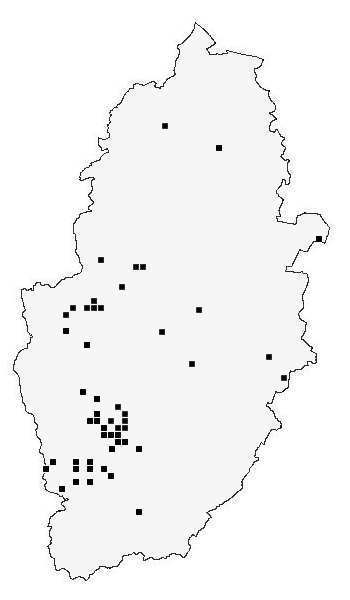 |
|
| .... | . | Map copyright © Trevor and Dilys Pendleton (www.eakringbirds.com) |
| .... | ||
|
Contributors to the distribution map Records for the distribution map are currently provided by the following :- Trevor and Dilys Pendleton. Wil Heeney. Gary Joynt. Sean Tobin. Tim Sexton. NBGRC. Peter Smith. Wayne Ball. Julie Rushby. Royal Horticultural Society (Rosemary Beetle monitoring scheme). Claire Watson. Adrian Dutton. Michael Walker. Elaine Cherrill. Andy and Libby Borroff. David Shaw. |
||
| .... | ||
|
Life history/early stages Adults wander and will turn up in unexpected sites, even well away from any hostplant. For a number of years, they have been resident on the Rosemary and Lavender growing in pots in our Market Warsop garden. The first appeared on a fence post on 11/09/17 and they have been more or less ever present since, but never in unmanageable numbers. During that time, we have taken many photographs and have been able to illustrate the early stages of this beautiful (if unwanted by many) beetle. |
||
| Adult Chrysolina americana. Length around 8mm. From a distance appears dark brown with an obvious metallic sheen. | Chrysolina americana eggs on Rosemary Salvia rosmarinus. These were photographed on 12/05/19. | |
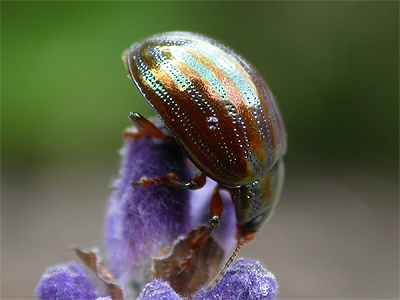 |
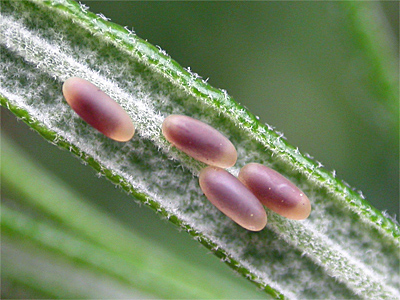 |
|
| .... | ||
| Half-grown Chrysolina americana larva on Salvia rosmarinus, photographed around a fortnight after being recorded in the egg stage on 27/05/19. | Full-grown larva on Salvia rosmarinus, photographed on 06/06/19. Egg to pupal stage (not recorded here) is thought to take around a month. | |
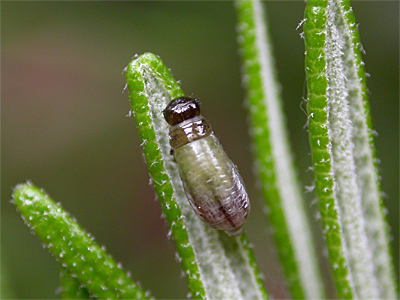 |
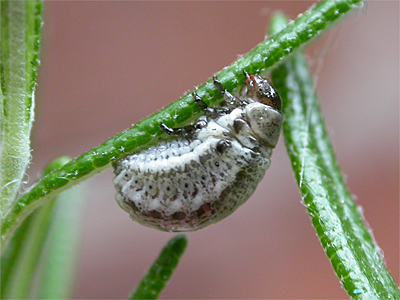 |
|
| Beetles |
| Homepage |